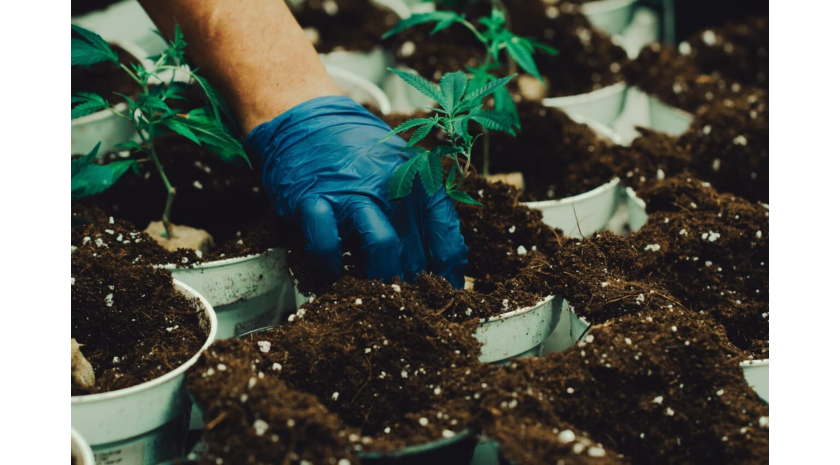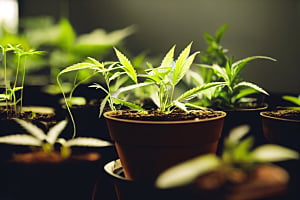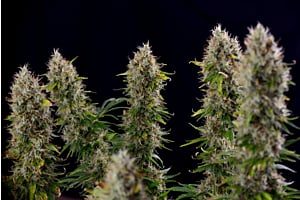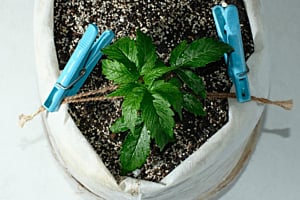Did you know that dirt is essential for a successful weed-growing venture? It can mean the difference between healthy bud-producing plants and a poor harvest. It’s also the component that’s easiest to modify—but how do you choose the best soil for cannabis?
Discover the criteria that make the grow medium most effective for your marijuana crops. Learn about soil pH, nutrients, water retention, and texture. Find out which soil is suitable for indoor and outdoor cultivation and the best fertilizers to help your cannabis plants flourish. By the time we’re done, you’ll know exactly how to provide the best medium for your marijuana crops to thrive.
What makes soil suitable for cannabis growing?
While weed grows in many types of dirt, there are vital criteria for it to thrive. An excellent cultivation medium helps plants produce abundant cannabis trichomes and high THC, CBD, and other cannabinoids.
The elements that contribute to the best soil for marijuana include:
- Optimum soil pH
- The right balance of nitrogen to phosphorus
- Perfect fungus-to-bacteria ratio
- Consistent amendments
- Proper drainage
- Sufficient water retention
The right pH for cannabis soil
Soil pH is critical to ensure sufficient nutrients are readily available for absorption by your crops. It’s a measure of water acidity or alkalinity—a reading of 7.0 and below indicates the former, while values above 7.0 reflect the latter. The water must be slightly acidic for cannabis plants. They thrive at a pH of 5.0–7.0, but the optimal level is between 5.8 and 6.3. Readings outside that range may restrict growth.
When pH is low, micronutrients—such as manganese and iron—are more available to your cannabis plants, potentially causing toxicity. Raising the level reduces their solubility and uptake by your crops.

Test your soil pH every two days and adjust if necessary. Testers are inexpensive and easy to use.
Correct nitrogen-to-phosphorus ratio and other essential nutrients
Cannabis plants need many nutrients for healthy growth. The five most crucial the best soil for growing weed must provide are:
- Nitrogen (N)
- Phosphorus (P)
- Potassium (K)
- Calcium
- Magnesium
When feeding your plants organic nutrients for weed, using the right mix is vital as they require varying amounts during each growth stage. When you buy fertilizer, check the NPK (nitrogen, phosphorus, potassium) ratios on the packaging, indicating their suitability for your plants’ development.
Discover why proper nitrogen-to-phosphorus balance is critical as we discuss the three primary nutrients and their functions.
Nitrogen
Cannabis plants need more nitrogen in the vegetative phase. It’s a key component of chlorophyll, which they use in photosynthesis. Without it, crops can’t convert sunlight into energy. The soil must have sufficient nitrogen for your plants to feed themselves. The element boosts root development and strengthens your crops. It’s vital to enable your marijuana plants to absorb phosphorus for robust growth.
Phosphorus
Another crucial nutrient the best soil for cannabis must include is phosphorus. The element absorbs the sun’s energy to help your marijuana plants produce huge, healthy buds. Without a sufficient supply of the substance, your crops may not develop strong roots.
Potassium
Cannabis plants need potassium to promote healthy growth. The element controls salt and water concentrations and boosts ATP production, storing energy for crop development. During the flowering stage, the requirement for K increases, and nitrogen decreases.
A balance of fungus to bacteria
The best soil for marijuana should have a balanced ratio of fungi to bacteria. Both decomposers play a vital role in recycling nutrients for your cannabis plants. Higher content of these microbes means healthier soil and more energy for crop growth. There’s a distinction in how fungi and bacteria process plant residues and nutrients. They have separate habitats within the soil and consume different types of organic matter—the former uses carbon, and the latter prefers high-nitrogen substances.
Fungi assimilate and store nutrients more efficiently than bacteria because of their carbon cell walls. The polymers of melanin and chitin make them highly resistant to degeneration. Increasing the former’s population in the soil boosts the optimal production of healthy plants. Bacteria have energy-rich membranes that degrade quickly and easily, making them excellent food sources for microorganisms.
To produce the best soil to grow cannabis, stimulate the growth of these microbes, and maintain the right balance to make the dirt productive.
Nutrients and amendments
Soil amendment is the process of adding material to enhance its quality. Without it, your plants deplete the available nutrients—your crops can’t grow well and may wither and die. While commercial soil contains the nutrients your marijuana plants need to develop, they often last about 3–4 weeks. Add more of the best nutrients for cannabis when your crops bloom, as that’s when they run out of food.
If you’re not amending your soil, it needs to have organic matter like compost, worm castings, humus, and guano. An excellent growing medium contains these substances and minerals that microorganisms convert into available nutrients for cannabis plants.
Water retention, texture, and drainage
Soil texture, drainage ability, and water retention are integral to marijuana plant growth. The best soil for weed is one that’s light and loose because it promotes root development. You get healthy cannabis crops because more oxygen supply reaches the roots. Excellent soil drainage is critical for weed growth. If the water sits when you hydrate your plants, they may get sick or die. Pay close attention when adding moisture so that there are no pools on the surface.
Your soil also needs to hold the right amount of water, so plants don’t become dehydrated. The growing medium needs a balance of drainage and retention ability. Loamy soil—a mixture of clay, silt, and sand with organic material—is perfect as it has all the essential components:
- Light and loose texture
- Optimal water drainage and retention
- Oxygen-rich and has plenty of nutrients
The best soil for growing cannabis outdoors
When cultivating cannabis using outdoor seeds, know that although the soil outside is natural, there are three main types:
- Clay
- Sandy
- Silty
- Loamy
The types also vary—sandy/clay, loamy/sandy, clay/loamy, or combinations of the three. Each includes different ratios and has its pros and cons.

The best soil for cannabis to cultivate outside is one with a balance of water retention, drainage, and an adequate supply of nutrients. Use an organic medium with those components to help your plants grow strong and healthy. Ensure your soil contains plenty of nitrogen, phosphorus, and potassium. The best soil for outdoor weed must include these essential elements throughout your cannabis plants’ growth cycle.
Monitor the levels of all three nutrients because deficiencies result in your plants producing low-quality buds, being unhealthy, and even dying. Whenever there’s a shortage, flush and amend your soil using a fertilizer with the correct NPK ratio depending on the growth stage. Combine your soil with organic nutrients instead of commercial ones. They’re inexpensive and include:
- Fish meal
- Blood meal
- Bone meal
- Bat guano
- Wood ash
- Kelp meal
- Dolomite lime
- Epsom salts
Cultivating marijuana plants outdoors in pots is another option. Monitor the temperature, humidity, sunlight, and rainfall. Keep an eye on pest infestations. Containers are portable, so you can move them indoors when necessary.
The best soil for growing cannabis indoors
If the weather in your region isn’t suitable for outdoor cultivation, what’s the best soil for growing weed indoors? Use high-quality potting soil. Avoid dirt with non-natural extended-release fertilizers as they’re unsuitable for growing cannabis. The best option is loamy soil with the perfect sand, silt, and clay balance. The ideal ratio should be 20%, 40%, and 40%, respectively.
Ensure the soil has a loose and light texture to facilitate root growth and maximize oxygen supply to your plants’ roots. When growing weed indoors, the potting medium must allow water to drain correctly. Excess pools of liquid cause plants to mold and suffer from root rot. Proper drainage doesn’t mean that water needs to be completely flushed away. The soil must hold sufficient liquid to allow the roots to absorb it along with nutrients. The ideal medium for growing indoors has to balance both functions.
Soil pH should be between 5.8 and 6.3 for optimal cannabis plant growth. When it’s beyond that range, you risk restricting crop development. Use a pH reader every 2–3 days to check and make the necessary adjustments. Ensure there’s no deficiency when the nutrients in marijuana soil deplete by inspecting your plants and amending the dirt.
If you’re looking for soil perfect for indoor and outdoor use, consider this mix from Fox Farm.
Fox Farm Happy Frog Organic Potting Soil Mix
This organic potting mix provides the nutrition your plants need to flourish. It may be costly, but you get excellent results, thanks to the following benefits it offers:
- 100% organic
- Ready to use—no mixing necessary
- pH adjusted to boost nutrient absorption
- Contains humic acid and mycorrhizae
- Ideal for indoor and outdoor use
- Provides an excellent coverage area for microorganisms to thrive
The best soil for autoflowers
There are two types of marijuana plants. Photoperiods rely on the light cycle to trigger their flowering phase and require plenty of nutrients to thrive. Non-photoperiod plants grown from autoflowering seeds begin producing buds when they reach a certain age. Their life cycle is shorter than their counterparts.
The most suitable medium for autos is light and airy, containing a low level of nutrients. Photoperiods use compact soil mixes that can work for autoflowers, but a lighter one gives you better results. Avoid using ‘natural’ soil or dense, rich organic options as you risk burning the roots and reduce yields.
Ensure your soil doesn’t retain excess water as autoflowers don’t need much moisture. Autos prefer dirt that dries out, but not entirely, so their roots extend to find food and increase auto yields. The peat-based matter is the best soil for growing marijuana autos, with some light amendments to raise its nutrient content and avoid cannabis deficiencies. Worm castings are ideal for the purpose—but don’t mix the matter with the soil as you do with photoperiods.
Add a layer at the bottom of the pot and top up with at least 50% of loose or preferably “soil-less” medium. Instead of buying commercial soil, make your own mix using the following ingredients:
- 3 parts compost
- 3 parts peat moss
- 2 parts wet perlite
- 1 part wet vermiculite
Keep the pH of your water within the 5.8 to 6.3 range to ensure sufficient nutrients are available to your autoflower plants. One of the best natural options for autoflowers is Super Soil Autoflower Concentrate.
Super Soil Autoflower Concentrate
The Super Soil Autoflower Concentrate has everything your autoflower plants need for optimum growth from seed to harvest. It’s a living soil—containing fungi and microbes—that doubles as a super soil. As a concentrate, you must mix it with regular potting dirt before use. As the name suggests, the solution works best for autoflowers and, to a lesser extent, other cannabis plants.
The best potting soil for cannabis
Buying soil from a garden store is quick and easy. Look for those labeled “potting soil” or “potting mix.” We recommend organic ones because they produce high-quality buds for recreational and medicinal use. You save time and don’t have to learn to make your own potting soil for cannabis. These manufactured soil mixes are perfect for beginners and experienced growers. They contain the macronutrients, micronutrients, beneficial bacteria, fungi, and vitamins your plants need.
Avoid soil with time-release chemical nutrients as you can’t control the type of nutes you give your cannabis plants and when. Improper feeding and timing can be disastrous for your crops. A potting option that ticks the boxes for growing cannabis is Sungro's Black Gold all-organic potting soil.
Tip: Don't forget to read about choosing pot size for autoflowers. This guide is very helpful.
Sungro Black Gold All-Organic Potting Mix Plus Fertilizer
This fully organic potting soil is loamy and contains perlite and pumice for microorganism growth and hydration. Its nutrient blend is balanced—it doesn’t cause “nute burn” to young plants.Black Gold is a high-performance soil that delivers excellent results but doesn’t burn a hole in your pocket.
8 ways to improve soil quality
If your existing soil isn’t ideal, improve its quality with the following options.
Fertilizers
If you have soil rich in organic matter, don’t add fertilizer because doing so may cause “nute burn” that harms your plants. Before adding materials like vegetable scraps, compost them first. When using commercial fertilizer, check the label to ensure you get the correct NPK ratio for your plants’ growth stage. To avoid feeding excess nutrients, use a lower dose than recommended and adjust when necessary—the suggested dosage is usually high.
Store-bought fertilizers do an excellent job, but they can be costly, and you need to keep purchasing them. You also have to mix them before watering and flush your plants regularly to get the salt out. An alternative is to develop your own best soil for pot plants using the following methods.
Coco coir
Coco coir comes from finely ground coconut husks. Add it to soil or use it as a substitute. The fibers lighten compact dirt and have higher water retention capabilities. It also has a neutral pH level. To amend your soil, add up to 30% of coco coir to the existing matter. Monitor the nutrient content to ensure the mix is correct and sufficient to optimize your marijuana plant’s development.
Coco coir comes as a compressed brick—rehydrate it in water before using it. The result is a light and fluffy substance, ready to mix into your soil.
Clay pebbles
Clay pebbles are usually part of hydroponic systems, but you can use them to improve soil to get the best dirt for cannabis. They’re excellent for drainage when added to the bottom of your growing medium. They prevent water from pooling and causing root rot. Add clay pebbles on top of your soil as mulch. They help the growing medium preserve moisture by slowing down evaporation. The shade they provide suppresses weed and protects beneficial microbes from the sun’s rays.
Perlite and vermiculite
Many growers use perlite for soil amendment. The bright-white rocks improve airiness and drainage in the soil while retaining water. High-quality manufactured soil usually contains perlite but if you want to include it in your mix, avoid adding more than 10–15%. Excess amounts may cause your soil to become too light, resulting in nutrients leaking out.
Vermiculite is similar to perlite in many ways but works differently. The former makes your grow medium lighter and offers excellent water retention, while the latter is better for drainage and airiness. Make the best soil for growing cannabis by combining the two materials. They work well together, giving your soil the perfect balance of proper drainage and moisture retention. Adding 10% of vermiculite is adequate.
Worm castings
Worm castings are ideal for soil amendment as they’re natural. When worms consume organic matter, they refine them, reducing nutrients to a readily available form for plants to uptake. They also introduce beneficial bacteria and microbes into the soil. While the additive contains 4 to 5% more nitrogen than the typical soil, it doesn’t burn plants. The element is present in the mucous worms secrete when they digest food, releasing it progressively.
Worm castings ensure moisture is always available to your plants. They offer excellent water retention and prevent the soil from completely drying out. The pH-neutral amendment has humic acid, helping plants absorb nutrients. Add only about 25–30% to your growing medium.

Molasses
Molasses are another way to transform your growing medium into the best cannabis soil. When adding the nutrient-rich, sugary substance, soil organisms consume it and release nutes for your plant to absorb. The additive multiplies the beneficial microorganisms in the soil, improves water retention and structure, and increases the quality. Molasses also prevents weeds and ward off fungi and pests.
Use an organic brand and mix 1–2 tablespoons in five liters of lukewarm water before hydrating your plants. Do it once or twice a week, and stop about two or three weeks before harvest. Use un-sulfured molasses because sulfur can harm soil microbes.
Compost tea
Compost tea is organic and provides many benefits like protecting against pests and helping your plants grow healthy. Save money by making it at home—the process is simple. Add water to your compost, let it steep for about 24 to 36 hours, and then use it to hydrate your plants. Either pour it into the roots or make a foliar spray.
Compost tea can convert your medium into the best soil for pot as it contains beneficial bacteria and fungi. These organic elements enhance the nutrients in the ground, making your plants stronger. You avoid disease because the microbes consume the food in the dirt that attracts pests.
Bat guano
When made into a tea, bat guano is an excellent soil amendment. By adding water to the manure, your plants stay hydrated and are safe from burning. The solution provides your soil with nitrogen and phosphorus. The biologically rich earth makes nutrient absorption easy for cannabis plants, reducing the need for fertilizers. Using bat guano tea, you get robust crops with dense foliage and large, flavorful buds.
What’s the best soil for cannabis?
While choosing quality marijuana seeds is essential for a bountiful harvest, the growing medium you use is equally vital. The best soil for cannabis needs excellent water retention and drainage ability, optimum pH level, ideal texture, and sufficient nutrients.
Buying soil from garden stores is a convenient option, but you can also develop and improve the quality of your existing medium. Using amendments like those mentioned helps weed plants thrive.
Whichever choice you make, ensure that you monitor the nutrient and pH levels regularly as they can change. Now all that’s left to do is get some marijuana seeds to start your growing journey. Apply the techniques above and look forward to successful cultivation.

 THC
THC







